Water
Glaciers are important for water supplies partly because they store it, but mostly because they regulate downstream water flows throughout the course of the year. Glaciers release water in the dry season or summer, when societies most need it.
As glaciers shrink, at some point they will release less water and this is particularly critical during the dry season. This concern has generated significant worries in places like the Andes, where cities such as Lima, La Paz, and Quito rely on water from glacier-fed rivers. It is also of concern in the Himalayan region because so many people depend on water from rivers like the Ganges that originate in glaciated mountains.
But the science — although frequently simplified in alarmist language in media and NGO reports — is far from definitive about the complex relationship among climate change, glacier retreat, glacier runoff, downstream water supplies, and human management of those water supplies. It remains unclear, for example, at what point in the future specific glaciers will begin to generate less runoff. That is, does a glacier need to shrink by 80%, 50%, or 10% before the runoff starts to decline? And at what point in the future, under which climatic scenarios, will the glacier reach that size? And concerns often neglect the human dimensions: how will a society respond to diminishing water supplies?
Despite the questions that still need investigating, there is little doubt that continued glacier retreat in the future will at some point negatively affect water supplies. Societies have started to respond to real and perceived threats of declining water supplies beneath shrinking glaciers. An ongoing several-year conflict at Peru’s Lake Parón, for example, demonstrates how uncertainty about future climate change, glacier retreat, and water supplies have further strained a long-standing preexisting struggle over the legal and political rights to manage water in Llullan River above Caraz.
